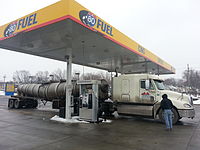
Photo from wikipedia
Abstract The restricted waterway is usually regarded as the bottleneck of port transportation. Many factors influence the overall efficiency and safety of the waterways. In this paper, an attempt is… Click to show full abstract
Abstract The restricted waterway is usually regarded as the bottleneck of port transportation. Many factors influence the overall efficiency and safety of the waterways. In this paper, an attempt is undertaken to investigate how the parameters related to LNG carriers, general ships, waterway dimensions and weather conditions affect the navigation risk and efficiency of restricted two-way waterways. Three indices including one efficiency and two risk indicators are adopted as the objective functions. To determine the correlations between the input and output factors, a traffic simulation model is constructed, which synthesizes the navigational rules, the impact of LNG carriers, the interactions among ships, the arrival characteristics of ships, among others. Subsequently, an Elementary Effect method based iterative procedure is developed to identify the influential and non-influential factors. Numerous experiments are performed by integrating the simulation model with the iterative procedure. The results reveal that the ships' arrival rate, mean and variance of ship speed and channel length are the most influential factors. LNG carriers’ speed and arrival rate have remarkable nonlinearities and/or interactions with other factors. These findings are valuable for the guidance of improving the efficiency and safety strategies implemented in restricted waterways.
Journal Title: Ocean Engineering
Year Published: 2019
Link to full text (if available)
Share on Social Media: Sign Up to like & get
recommendations!